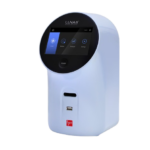A blue light transilluminator offers some unique advantages over UV transilluminators, especially when the intent is to use the system on top of the bench and out in the open. Some of the unique advantages of the the blue light transilluminator over UB boxes is there is no risk of damaging or photobleaching DNA during excitation. Ultraviolet excitation has been known to damage DNA via thymine dimer formation and strand breaks. This can lead to decreased efficiency in cloning and transformation (Paabo et al. 1990, Grundmann and Schomig, 1996)
A blue light transilluminator is also more safe to work with on the bench versus a UV transilluminator. Exposure to ultraviolet radiation (commonly between 302nm and 315nm) during exposure on the bench can cause damage to human tissue in the eyes and skin. “Ultraviolet ransilluminators have the potential effects on eyes (photokeratitis, photoconjunctivitis and cataracts) and skin erythema (sunburn like condition) elastosis (photoaging and skin cancer). Hands, arms, face and eyes are likely sites of injury. Working unprotected for even a few minutes can cause injury. Some individuals have greater than usual photosensitivity. ”
“Effects of UV can occur within a short period (photokeratitis and erythema) or a long period after exposure (skin cancer). It is possible to calculate acute threshold for acute effects and therefore set exposure limits, however it is not possible to do so for chronic effects, therefore there is no safe exposure level and exposure should be reduced as much as possible.”
Some recommended suggestions are as follows:
- Wear laboratory coats.
- Wear lab glove.
- Ensure skin is not exposed between the sleeves and gloves.
- Wear a face shield
Optimally, the UV transilluminator should be in a darkroom of a gel documentation system. Syngene gel documentation systems offer complete UV safety and will automatically shut-off lights as the darkroom door is opened or after the image has been captured.
Many researchers wish to cut bands from the gel and typically, this is performed on the bench. As such, UV transilluminators are one on the most commonly found items in the lab. However, a blue light transilluminator is a much safer instrument to work with on the bench. A blue light transilluminator does not damage DNA and there is no risk of burning eyes or skin. With this in mind, a blue light transilluminator is recommended for use on the bench.
New England BioGroup is committed to making sure researchers have access to blue light transilluminators at a reasonable price and they can be purchased through Transilluminators.com, our online marketplace. Safety should not be a financial decision! We are available to speak further and help you select the blue light transilluminator that best fits your needs.
For more information, please see our Blue Light Transilluminators: The Definitive Guide article.


